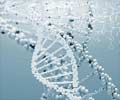A new gene therapy has been developed by researchers at the Vanderbilt University that could be the answer to a genetic disorder called Isolated Growth Hormone Deficiency type II (IGHD-II).
IGHD-III is genetically inherited deficiency and occurs in one in 4,000 to 10,000 children.Children with IGHD-II look quite normal at the time of birth but do not put on weight or grow as fast as they should and their bones also do not mature properly.
The research shows that a new gene therapy called RNA interference can “rescue” a strain of a genetically engineered mice to express a defective human hormone that interferes with normal growth.
The researchers found when the gene that generated defective human growth hormone was inserted into the mouse’s genome, it affected the mouse’s development.
John Phillips, Professor of Pediatrics at the Vanderbilt University Medical Centre, who has been studying human growth deficiency disorders since 1978 said that they are glad to find the cause and identifying the way of preventing the genetic disorder.
“It has been very satisfying to figure out the underlying cause of this genetic disorder and then identify a way to prevent it,” he said.
Advertisement
The researchers believe that the treatment fails to correct the underlying source of the problem including deterioration and death of cells in the pituitary gland that produce growth hormone.
Advertisement
“It acts like Aesop’s dog in the manger … which has no use for the hay but keeps the cows from eating,” said Phillips.
The co-author Iain Robinson at the National Institute for Medical Research in London had also created a transgenic mouse, earlier, with the human growth hormone gene that replicated the growth hormone deficiency.
He found that increased levels of the defective human growth hormone not only affected their growth but also killed the cells in the pituitary, which produces growth hormone.
“This came as a real surprise: We never thought that a splicing error would lead to cell death,” said Patton.
Scientists have realized that short pieces of double-stranded RNA, called silencing-RNA, followed a pathway used by cells to regulate genes.
In order to deliver it to the pituitary gland of the mouse that is the size of a grain of uncooked rice and located at the base of the brain they created a second strain of mouse that carried the special silencing-RNA and mate them with the growth deficiency strain.
“To the best of our knowledge, this is the first time it has been used to correct a dominant negative disorder in a living animal,” Patton added.
The study was published online on Nov. 15 by the journal Endocrinology.
Source-ANI
LIN/P









